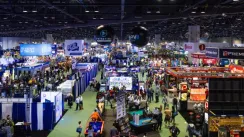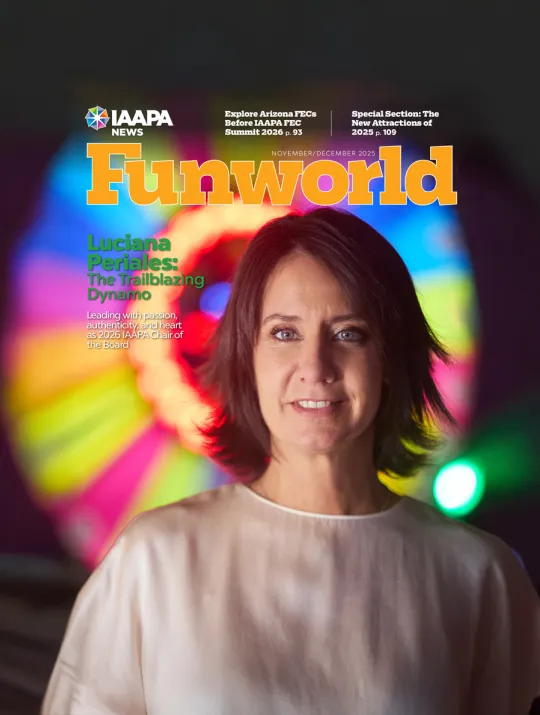- For Attendees
Tour button
Booth Layout/Display Guidelines for Expo Middle East

Raw/space only or special design exhibitors of any size, and exhibits displaying inflatables, MUST submit:
- Detailed booth layout floor plan including stand elevation, electrical fittings, colors.
- Materials and audio visual equipment to be used with dimensions in scale (not less than 1:100).
- Front and side view drawing(s) with booth height.
- 3D Perspective drawings.
- Elevation views showing clearly all dimensions, graphics, etc.
- Structural calculations / drawings proving structural stability, weight loadings, colors and details of the materials to be used for booth etc.
- Fire precaution and protection.
- Fire-retardant materials must be clearly noted in your booth layout
Please note that raw/space only exhibitors must provide a wall between their booth and any neighboring exhibitors that must be a minimum of 3m in height. 3m deep booths maximum height for walls and display components is 3m.
Booth design drawings must be submitted online to IAAPA Show Management by 13 February 2026. Once approved by IAAPA, the drawing will be sent to ADNEC Centre Abu Dhabi for their review and approval. Any exhibitor attempting to build an exhibit without IAAPA or the building approval will not be permitted to set-up or will be forced to close their space until the design has been approved. In addition, late form submissions are subject to a fine and/or loss of seniority as outlined here.
All space-only exhibitors are required to pay an inspection fee to the stand vetting safety team. This fee covers the review and approval process to ensure all stand designs meet the required safety and construction standards. More details, including the applicable rates and payment instructions, will be made available soon.
Please note that only stands which are classed as ‘Complex Structures’ will be reviewed and assessed by the ADNEC Structural Engineer prior to the commencement of the tenancy. There is currently no requirement to submit plans and designs for stands, booths or features that will be in use during an event if they do not fall within the ‘Complex Structure’ definition.
Complex Structures are purpose-built stands, structures, booths or features which are over 4 meters in height; double-decker in design; have a platform of 600mm or more or which have a complex design which is deemed to be ‘non-standard’ with a complicated construction process.
• Definition of a Complex Structure:
- Double Decker stands
- Any part of a stand or exhibit which exceeds more than four meters in height
- Certain suspended items, e.g., lighting rigs or signs over 400 kg
- Sound/Lighting towers
- Temporary tiered seating i.e. Grandstands
- Platforms and stages over 0.6m in height and all platforms and stages for public use
All work must be carried out in conformity with the requirements of the Rules and Regulations of ADNEC Centre Abu Dhabi.
It is the duty of all exhibitors and their contractors to take reasonable steps to ensure that people (visitors) with disabilities are able to access and make use of those services.
It is the duty of all those providing services to visitors, to take reasonable steps to remove, alter or provide a reasonable means of avoiding physical features that make it unreasonably difficult or impossible for disabled people to make use of their services.
All stand structures, signs, notices, etc. must be confined within the area allocated and must not project into or over the gangways.
No suspension may be made from the roof of the exhibition halls, nor may any fixings be made to the structure of the building.
Suspended Fittings
Suspended stand fittings are not permitted. ADNEC may permit suspension from the hall roof of banners, lighting, fittings or other decorative materials (the work being carried out by ADNEC at the expense of the Exhibitor) or by the ADNEC Centre Abu Dhabi rigging Contractor provided that:
They form part of an overall scheme of decoration proposed by the Exhibitor.
There are no locking arrangements to the main body of the stand (including electric wiring or decorative materials).
The proposed suspended units to not overstress the roof structure max 70kg/r/m.
Time is available after the beginning and before the end of the rental term for ADNEC Centre Abu Dhabi.
Rigging Contractor to remove the suspension wires, with free unobstructed access at floor level for hoist vehicles, cranes etc. as may be required.
Use of Mortar
Persons proposing to erect brick, stone, or block walls, etc. shall lay heavy Duty building paper or similar material on the floors under the walls, etc. to protect the floor surfaces from any mortar damage. The cost of repairing any damage caused to floors by the erection or dismantling of this work will be charged to the Exhibitor.
The building height in the exhibit halls is 6m for a normal booth, and the maximum height for a double-story booth is 8m. However, exhibit fixtures, components, and attached identification signs are permitted to a maximum height of 6m for raw space booths greater than 3m deep. Shell scheme booths and raw space booths 3m deep are limited to 3m height. Double-sided signs, logos, and graphics higher than 3m from the ground must be set back 3m from adjacent booths or be covered/finished on the side facing the adjacent booth.
Exhibitors may request a variance to the height rule that are bringing product for product that extends beyond the height limit from the floor if neighboring site lines aren’t blocked. Variances are reviewed and approved on a case-by-case basis. Please upload proposed layout online to IAAPA Show Management by 13 February 2026.
Hanging Signs are permitted in booths that are 6mx6m and larger. All signage must be contained within the contracted booth space. Double-sided signage must be set back at least 3m from adjacent booths.
Rigging
All rigging at the venue, will be undertaken solely by ADNEC Centre Abu Dhabi Services. Rigging of banners, etc. above individual stands or rigging of stand structures from the hall roof will only be permitted at ADNEC’s discretion.
- Exhibitor must, therefore, advise IAAPA Show Management and ADNEC Centre Abu Dhabi Services of their rigging policy (i.e., whether rigging is permitted above individual stands or limited to certain areas) and include such advice in their exhibitor manual.
- Rigging will be subject to sufficient time and access being available to carry out such operations safely and must be carried out within the license period, unless otherwise agreed by ADNEC Centre Abu Dhabi.
- Floor to ceiling rigging is not permitted.
- Rigging orders should be placed with the service provider no later than 20 working days prior to the start of the license period (late orders will be subject to a surcharge). The following details should be provided with the order:
- A fully dimensioned, to-scale drawing indicating the orientation of the stand in relation to the building.
- Description and number of items to be rigged.
- Load on each suspension point.
- Preferred suspension height from the floor and hook height (taking into account any bridling which may be required).
Dates and times of lifting and lowering operations.
All rigging shall comply with ADNEC’s Rigging Code of Practice.
- If lighting trusses, specially designed flown items, or any items weighing over 250kg are to be suspended, due to venue weight restrictions, drawings and load information must be supplied to ADNEC Centre Abu Dhabi no later than 35 days prior to the license period. All submissions past this date will be subject to delivery and surcharges.
- Timber structures must be appropriately bolted and braced. Timber cladding attached to trusses must be fixed using a clamp or hanging bracket which supports the underside of the structure. Free climbing of flown equipment is prohibited. Equipment to be accessed at height must have a suitable safety system, providing a constant means of attachment. A plan for the rescue of people working at height must be in place, in the event of any emergency.
- Fascia’s - Where fascia are suspended, each individual section of fascia must be supported. Facias of five meters and over in length must be supported at three points on each section from securely attached brackets. The weight of the fascia must be supported from the underside.
- Banners and signs - Banners and signs should be delivered to the rigging service provider no later than ten days prior to the start of the license period and must be delivered in a complete identifiable state, fit for suspension. The suppliers of the signage are responsible for its integrity and that of its suspension points.
- Metal or timber-framed signs may only be rigged if fitted with fully captive lifting points bolted through the full depth of the sign, the capacity of which must be sufficient to support the load completely on any individual point. Screw-in eyes are not acceptable for this purpose and ADNEC Centre Abu Dhabi reserves the right to refuse to allow the suspension of any signs where the suspension lifting points are inadequate.
- Due to their flimsy nature, paper signs may only be suspended if constructed from ‘Tyvec’, or a similar material approved by ADNEC Centre Abu Dhabi.
- Flown banners should have a 100mm sleeve at the top pocket to carry a 50mm diameter aluminum scaffold tube to be passed through or a suitable width for provided poles. Any weight at the bottom of the banner must be captive. All pockets and captivities to be a vinyl weld construct. Glued and or taped pockets are not permitted.
- ADNEC Centre Abu Dhabi undertakes to ensure that the suspension of signs is carried out in a safe manner and reserves the right to alter suspension fittings whenever considered necessary. Any additional cost incurred in such actions will be payable by the licensee.
- For health and safety reasons, banners will only be de-rigged at the end of the license period. They must be collected immediately; otherwise, they may be disposed of.
- Hoist and fix - Contractors undertaking hoist and fix operations must submit suitable risk assessments, method statements and confirmation of compliance with LOLER and PUWER. For further advice, please contact the IAAPA Show Management.
- Rigging is not permitted in the Atrium, Concourse, Capital Suites, Conference Rooms or Hall Main Entrances.
Multi-storey Stands and Stand fitting exceeding 4.0m in height (see also ‘Complex Structures’).
Multi-storey stands, elevated gangways and stairways and stand fitting exceeding 4.0m in height must be constructed to the requirements of ADNEC. Details of multi-storey stands etc. must be submitted to ADNEC, with structural calculations, 60 days prior to the first day of tenancy.
Ceilings – other than to the topmost storey shall be of solid construction of an inherently non-flammable fabric, except that treated fabric may be permitted to single storey portions of stands where not exposed to the risk of fire from lighted articles dropped from above.
Cupboards - formed beneath the staircase shall be lined throughout with non- combustible material.
Adequate means of escape - must be provided from the upper storey of any stand.
Staircases - shall be at least 1m wide and if not subdivided by a central handrail, no more than 1.8m wide. Each step shall have an available tread, measured on plan, of 280mm; the risers between steps shall be unfilled and shall not exceed 180mm. Any handrail(s) or balustrades must have vertical railings not more than 100mm apart or solid infill.
Staircases shall discharge to the ground floor at a point where unimpeded access to a public gangway is achieved. If the occupants of the upper storey have no choice but to exit by way of a single escape stair, the travel distance from any part of the storey to that stair must not exceed 10m.
Structural Calculations - In all cases, calculations proving the strength and stability of structures will be required to demonstrate the following requirements of the ADNEC Regulations. In this context, the word “structure” means either a multi-storey stand or any part of a stand higher than 4m.
A loading analysis assuming an imposed load (‘Live load’) on upper floors of 5 KN per sq. m. Dead loads should be individually assessed for each floor.
A stability check assuming a lateral load equal to 2.5% of the total vertical load applied at upper deck level.
Stress and deflection checks for all structural members.
Details of connections, bracing members and floor carcasing.
In all cases a wind load of 0.15 KNm2 shall be accommodated.
Note: In certain circumstances when an upper area is not freely accessible to general exhibition visitors and the number of persons shall not exceed 1.5 sq m per person, a minimum imposed load of 3.5 kNm2 will be accepted. On such occasions the stand-holder will be required to demonstrate a robust system of controlling access onto the upper area to avoid exceeding the stipulated number of persons. Structural calculations will be provided for handrails and balustrades.
All display components must be contained within the contracted space. Nothing can extend into the aisle from the ground or hanging into aisle. This includes the distribution of materials. Exhibit staff should remain within your booth space. Please be sure your staff remain within the booth while handing out materials.
Exhibitors whose product produces fumes, gases or waste such as fog, confetti or bubbles, (but not limited to these examples,) must keep these emissions and products contained within their booth. This means that all emissions need to be vented, trapped or collected so as not to impact on any neighboring booths. Non-compliance will lead to your product being turned off and/or having your booth closed. IAAPA reserves the right in its sole judgment to prohibit or close any display or activity because of noise, odors, or other disturbing features, or which may be offensive to other exhibitors or attendees.
All booths, including inflatables, may only utilize 75% of contracted space leaving 25% of the footprint of their booth space free and clear and most of this open space should be open on the side of the closest or adjoining exhibitors. Please be sure there is adequate space for your staff and customers to stand within your booth so the aisles remain clear.
All blowers used at any time must be clearly labeled as UL or ETL approved or carry a comparable acceptable designation. All blowers must have a built-in thermal overload protection. (IAAPA will have final decision rights on acceptance of comparable designations).
- All blowers are to be checked periodically throughout the day by the exhibitor.
- As per most manufacturer handbooks, blowers need to be plugged in to a GFCI outlet.
- IAAPA’s trade show safety inspectors will be inspecting blowers daily to make sure there is adequate ventilation area around the blowers. All blowers must be kept free and clear of displays, boxes and anything that could restrict or impede the flow of air to the blower. No flammable material is to be under or next to a blower.
- Any box or device used to dampen the sound of the blower must have been designed and manufactured for this purpose and have adequate space and ventilation for the blower and must be free of anything else inside the case. No extension cords can be stored in the box. IAAPA safety inspectors have the right to reject any of these boxes or devices.
All booths must have carpet or some form of floor covering over their booth space with no exposed flooring. Carpet is included with Shell Scheme booths.
- Exhibitors ensure that all carpet and carpet tape are removed completely after the event and before the end of your tenancy period.
Exhibitor will be charged for the non-removal of carpet and tape, or if any damage is cause to the fabric of the building because of its removal.
Carpet Fixing Tape
- Exhibitors are responsible for ensuring that adhesive tapes used to fix carpets or other materials to the floor areas are removed after use without damaging the floor.
ADNEC Centre Abu Dhabi requires the use of 3M low tack tape, which is a kind that can be easily removed. - The recommended double-sided fixing tape to be used is code B7 and comes in 50m x 50mm reels.
- Plastic packing tape, gaffer tape, masking tape or drafting tape, all of which are difficult tapes to remove from floors, are not to be used.
- Any tape not removed by the contractors will be removed by ADNEC at the Exhibitor’s expense.
- The use of carpet spray adhesive or glue is not permitted.
- Please ensure that all carpet tape is removed after your event and before the end of the expo. A charge will be made for the removal of any remaining carpet tape.
- Additionally, should the removal of the carpet tape cause any damage to the fabric of the building, the cost of “making good” will be charged to the exhibitor.
For accessible and safety reasons, raised flooring should be avoided whenever possible. Please review the Raised Floor Requirements here.
Partitions separating stands may be erected up to 4m (13’0”) high, but where a wall abuts an adjoining stand and projects above the partition, it must be clad and decorated.
It is the responsibility of Exhibitors who have taken “SPACE ONLY” sites to supply, erect and decorate freestanding single clad partitioning to the periphery of their sites where they adjoin an adjacent stand.
The minimum height of the partitioning must be 3m with a maximum height of 4m (13’0) of which the area above 3m must be of double-sided cladding and decorated to the choice of color and material as agreed by the adjacent exhibitor.
Grid A








 The Official Magazine of IAAPA
The Official Magazine of IAAPA